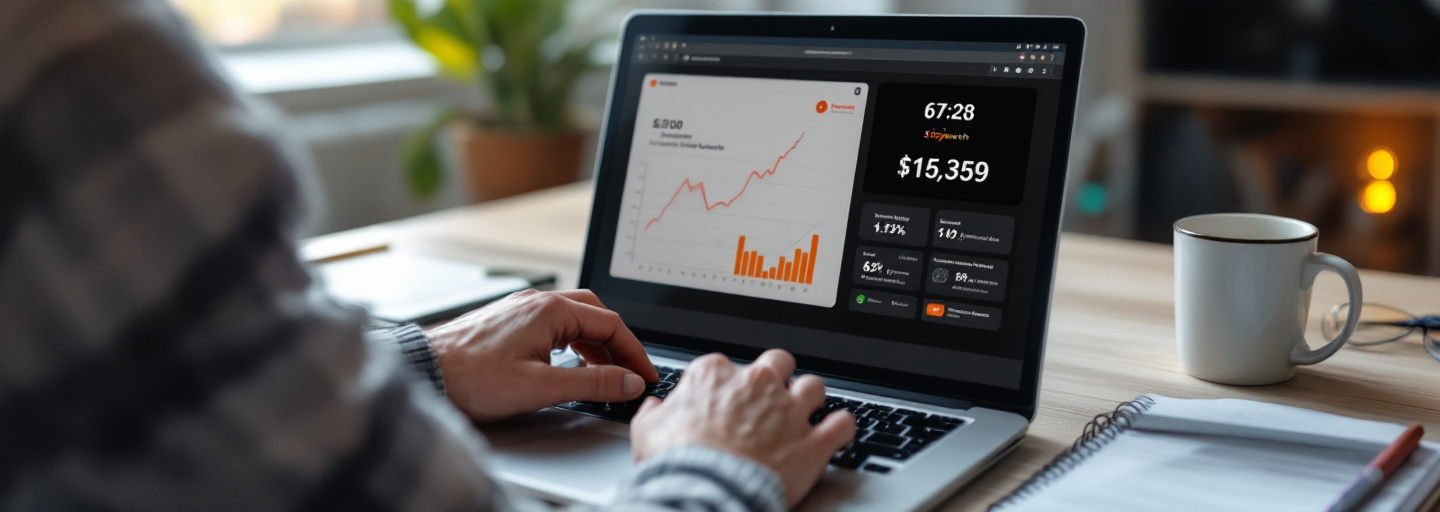How to Use Online Stopwatches for Better Time Tracking
« Back to all blog postsLearn how to use online stopwatches to track time better, boost productivity, and manage tasks more efficiently with simple, practical tips.
![]()
Every minute counts when you’re trying to get things done.
Research shows that people who track their time are 20% more productive than those who don’t, simply because they become aware of where their hours actually go.
Time tracking isn’t just about watching the clock—it’s about understanding your personal patterns and making intentional choices about how you spend your most valuable resource.
Why Time Tracking Matters in Daily Life
Most people underestimate how long tasks take by 40%, leading to constantly missed deadlines and growing frustration. This perception gap affects everyone from students to CEOs.
Time tracking creates awareness of patterns that would otherwise remain invisible. You might discover you spend twice as long answering emails as you thought, or that your most productive writing happens before 10 AM.
The simple act of measuring time changes how we use it. When you start a stopwatch before beginning a task, your brain receives a clear signal to focus. This psychological trigger helps eliminate distractions and improves concentration.
Students apply time tracking to balance study sessions across different subjects. Instead of spending hours on favorite topics while neglecting challenging ones, they allocate specific time blocks to each subject.
Professionals use time data differently. A graphic designer might track creative work versus client communication to ensure billable hours are maximized. A manager might discover that morning meetings run 30% longer than afternoon ones.
The value of time tracking isn’t in becoming obsessed with every minute. Rather, it’s about gaining honest insights into where your time actually goes versus where you think it goes.
What Makes Online Stopwatches More Useful Than Traditional Ones
The humble stopwatch has evolved from a mechanical device with a single button to sophisticated digital tools accessible anywhere. This evolution has transformed how we track time.
Physical stopwatches served their purpose for decades, but online stopwatches offer significant advantages in our connected world:
- Device flexibility – Access your stopwatch from any computer, phone, or tablet
- No additional hardware – Nothing extra to carry, lose, or have batteries die
- Data persistence – Many online stopwatches save your timing history automatically
- Feature richness – Digital tools offer lap tracking, visual indicators, and customizable interfaces
- Integration capabilities – Connect with other productivity tools in your workflow
Browser-based tools like AlarmClockTab’s stopwatch offer immediate access without downloads, making them ideal for both planned and spontaneous timing needs. You simply open a tab and start tracking.
The ability to access the same stopwatch across multiple devices creates consistency in your time tracking practice. Start timing a project on your desktop computer, check progress on your phone during lunch, and complete the session back at your desk.
For teams, online stopwatches enable shared timing experiences. Everyone can access the same tool without needing to purchase identical physical devices, making group time management more cohesive.
Using Stopwatches to Track Work Tasks Effectively
Implementing stopwatch timing for work requires a simple but deliberate approach. The key is starting small and building consistency.
Begin by identifying which specific tasks would benefit most from timing. These typically include:
- Tasks you tend to procrastinate on
- Activities where you lose track of time
- Work that requires billing or reporting hours
- Repetitive tasks you want to optimize
Time blocking pairs perfectly with stopwatch tracking. First, schedule specific blocks for different types of work. Then use your online stopwatch to track the actual time spent within each block.
Follow these steps to implement effective work time tracking:
- Select 3-5 key tasks to track initially (don’t overwhelm yourself)
- Set up your online stopwatch before beginning each task
- Record start/stop times in a simple spreadsheet or note
- Review your data weekly to identify patterns
Different professionals benefit from stopwatch tracking in unique ways. Writers can track words produced per timed hour, revealing their peak creative periods. Software developers might time debugging sessions to identify which types of problems consume the most resources.
For maintaining focus during longer work sessions, many professionals combine stopwatch tracking with structured work intervals using the Pomodoro technique timer , which complements open-ended stopwatch usage with defined work-break cycles.
The goal isn’t to create pressure but to develop awareness. Your stopwatch becomes a tool for understanding your work patterns rather than a source of stress.
Boosting Productivity with Stopwatch Challenges
Time constraints often trigger heightened focus and creativity. When we race against the clock, our brains eliminate distractions and zero in on the task at hand. Stopwatch challenges harness this psychological principle to transform mundane tasks into engaging activities.
Try these specific challenge formats to boost your stopwatch productivity:
- Beat Yesterday Challenge – Track how long a recurring task takes, then try to improve your time each day
- 5-Minute Sprint – Set your stopwatch for just five minutes of focused work on a dreaded task
- Focus Marathon – Start with 15-minute focused sessions, gradually extending your concentration period
- Time Audit Challenge – Track every activity for one day to discover where your time actually goes
These challenges work particularly well for:
- Clearing email inboxes
- Organizing digital or physical spaces
- Administrative paperwork
- Exercise routines
- Creative brainstorming
The element of competition, even if only with yourself, transforms routine tasks into more engaging experiences. Your brain begins to view the stopwatch as a game rather than a monitoring tool.
| Challenge Type | Best For | How It Works | Ideal Tasks |
|---|---|---|---|
| Beat the Clock | Competitive personalities | Set a target time to complete a task, then try to beat it | Email processing, data entry, cleaning |
| 5-Minute Sprints | People who procrastinate | Work intensely for just 5 minutes, then decide whether to continue | Starting difficult projects, quick organizing tasks |
| Progressive Focus | Those building concentration skills | Start with 10-minute focused sessions, add 5 minutes each day | Reading, studying, deep work |
| Time Audit | People unsure where time goes | Track actual time spent on routine tasks to identify inefficiencies | Daily routines, work processes, meetings |
Tips for Accurate and Consistent Time Tracking
Even with the best intentions, time tracking often falls apart due to simple human errors and inconsistencies. Acknowledging these challenges is the first step toward overcoming them.
Common time tracking mistakes to avoid:
- Starting the stopwatch after you’ve already begun working
- Forgetting to stop the timer during interruptions
- Tracking too many different activities at once
- Not labeling or categorizing your timed sessions
- Inconsistent tracking (some days yes, some days no)
For technical accuracy, position your online stopwatch where you’ll see it constantly. Some people keep it in a separate browser tab they check regularly, while others prefer it visible on a second monitor.
Building behavioral consistency requires linking stopwatch use to existing habits. Start your stopwatch immediately after opening your computer in the morning or right after your first cup of coffee.
Different activities require different tracking approaches—while stopwatches work best for open-ended tasks, AlarmClockTab’s timer is more suitable for fixed-duration activities where you need a countdown rather than elapsed time.
When reviewing your time data, look for these specific patterns:
- Tasks that consistently take longer than expected
- Time of day patterns in your productivity
- Activities that frequently get interrupted
- Your actual capacity for focused work each day
Remember that time tracking is a skill that improves with practice. Your first week will be imperfect, but consistency matters more than perfection.
Best Situations to Use Online Stopwatches
Online stopwatches shine in specific contexts where tracking elapsed time provides meaningful insights or motivation. Understanding when to use this tool maximizes its effectiveness.
Professional applications include:
- Tracking billable hours for client work
- Monitoring meeting durations to improve efficiency
- Timing presentation rehearsals
- Measuring how long different project phases take
For students, stopwatches prove invaluable when:
- Tracking study time per subject
- Timing practice tests to build exam readiness
- Measuring reading speed and comprehension
- Balancing homework time across different classes
Personal productivity applications include:
- Timing workout intervals and rest periods
- Tracking household chores to divide fairly
- Monitoring cooking processes
- Measuring how long daily routines actually take
For a comprehensive time management system, consider how AlarmClockTab’s suite of tools allows you to seamlessly switch between stopwatch functionality for tracking, timers for countdowns, and alarms for scheduling—all within the same browser tab.
| Activity Type | Stopwatch | Countdown Timer | Alarm Clock |
|---|---|---|---|
| Open-ended work sessions | ✓ (Best choice) | Limited use | Not suitable |
| Fixed-duration activities | Limited use | ✓ (Best choice) | Limited use |
| Tracking billable hours | ✓ (Best choice) | Not suitable | Not suitable |
| Exercise intervals | Good for tracking | ✓ (Best for structure) | Not suitable |
| Daily scheduling | Not suitable | Limited use | ✓ (Best choice) |
The flexibility of browser-based stopwatches makes them particularly valuable for people who work across multiple locations or devices throughout their day.

